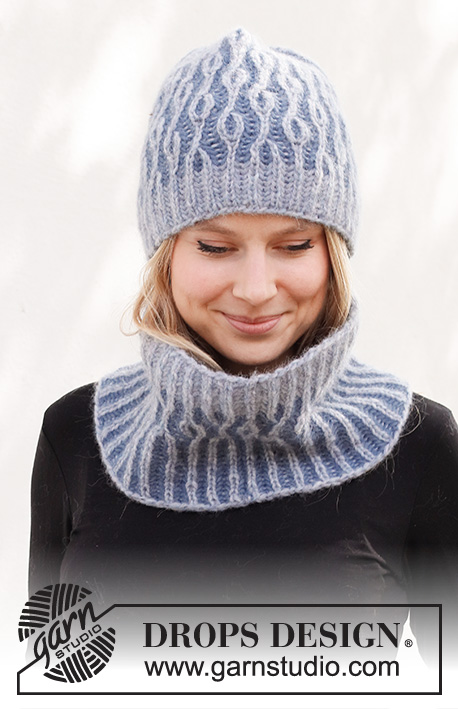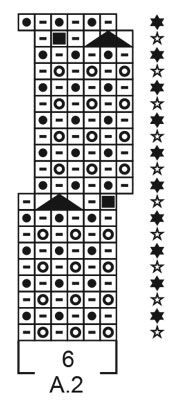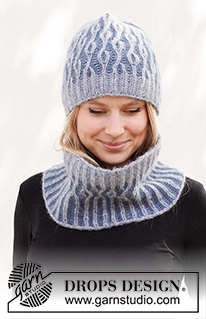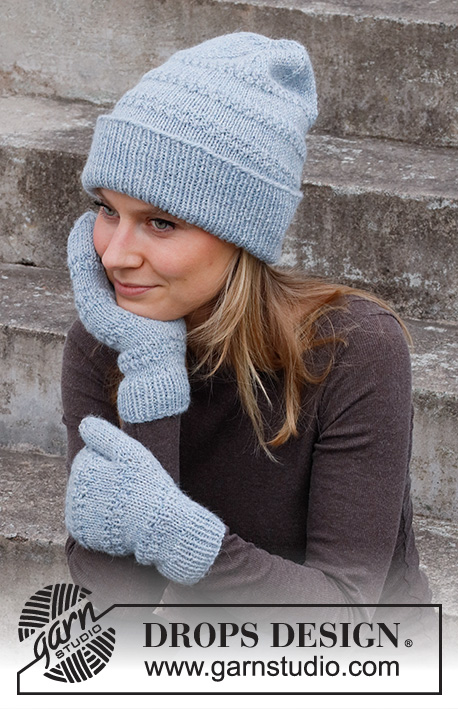Comments / Questions (23)
![]() Giovanna wrote:
Giovanna wrote:
Buonasera, sto provando a fare il cappello. Mi dice di avviare 99 maglie e di lavorarle Lavorare il motivo in tondo come segue: * 2 maglie insieme a diritto, 1 gettato, passare 1 maglia a rovescio senza lavorarla *, lavorare *-* fino alla fine del giro = 66-72 maglie. Ma alla fine del ferro ii ho sempre 99 maglie e non 72. Cosa sbaglio?
06.12.2024 - 20:29DROPS Design answered:
Buonasera Giovanna, nella lavorazione a coste inglesi i gettati non vengono contati come maglie. Buon lavoro!
07.12.2024 - 18:55
![]() Giovanna wrote:
Giovanna wrote:
Buonasera, sto provando a fare il cappello. Mi dice di avviare 99 maglie e di lavorarle Lavorare il motivo in tondo come segue: * 2 maglie insieme a diritto, 1 gettato, passare 1 maglia a rovescio senza lavorarla *, lavorare *-* fino alla fine del giro = 66-72 maglie. Ma alla fine del ferro ii ho sempre 99 maglie e non 72. Cosa sbaglio?
29.11.2024 - 17:00DROPS Design answered:
Buonasera Giovanna, i gettati nella lavorazione a coste inglesi non sono inclusi nel conteggio delle maglie. Buon lavoro!
07.12.2024 - 18:55
![]() Doris wrote:
Doris wrote:
Ich verstehe nicht, wie die angegebene Maschenprobe stimmen kann. 36 Reihen von Drops Air mit der Nadel 5 sollen 10 cm Höhe ergeben. Bei Garngruppe C! Bei der Anleitung für denn Pullover Merry Santas dagegen sollen bei gleicher Wolle und gleicher Nadelstärke 22 Reihen 10 cm ergeben. Das kann ich eher glauben…
18.11.2024 - 22:52DROPS Design answered:
Liebe Doris, beachten Sie, daß die Maschenprobe in Patentmuster und nicht Glattrechts gestrickt ist, dh für Patentmuster braucht man mehr Reihen als fürs Glattrechts; Viel Spaß beim Stricken!
19.11.2024 - 08:10
![]() PJ wrote:
PJ wrote:
Great, thanks. I'm now getting it (I think) but I'm now getting into issues working A1. I'll have another go but I suspect this may just be too advanced for me.
18.12.2023 - 10:43
![]() PJ wrote:
PJ wrote:
Like Aruna, I am not understanding the initial decrease. For each set of 3 stitches on the left needle, I am knitting 2 together, making 1 yarn yarn over stitch, and slipping 1 stitch. So continue to have 3 stitches. Pattern suggest this should be a decrease. Your response to Aruna was to 'knitting 2 sts together, YO, slip 1 as if to P' which is the same, i.e., no decrease. How are you making the 'yarn overs belong to the slipped stitch'?
17.12.2023 - 13:14DROPS Design answered:
Dear PJ, for the English rib pattern you work 1 stitch with a yarn over. This yarn over is not counted as a stitch, as it is not considered technically an increase. This yarn over will be worked together with a slipped stitch a few rows afterwards. In the pattern stitch counts, the yarn overs in the English rib are therefore not included so, since you have 1 decrease, it will be considered as having decreased 1 stitch. You can read more on the English rib here: https://www.garnstudio.com/lesson.php?id=67&cid=19. Happy knitting!
17.12.2023 - 19:47
![]() Daniela wrote:
Daniela wrote:
Buongiorno. Per eseguire il cappello dite di seguire il diagramma A1 e A3, ma poi nella descrizione parlate del diagramma A1 e A2! Inoltre cosa significa “ eseguire il diagramma A3 su A2” ?? Grazie
23.09.2023 - 21:21DROPS Design answered:
Buonasera Daniela, nelle indicazioni all'inizio del modello è riportato che per il cappello si devono seguire i diagrammi A.1-A.3, quindi dal diagramma A.1 al diagramma A.3; una volta finito il diagramma A.2 si prosegue con A.3 sulle maglie lavorate in A.2. Buon lavoro!
25.09.2023 - 23:08
![]() Jenni wrote:
Jenni wrote:
Jeg sliter med råd 9 på A.2: " strikk de neste 3 maskene rett sammen (og kastene some hører til maskene". Om det skal felles 2 masker, strikkes det totalt 3 masker sammen? Er det ikke flere om de kastene som hører til også strikkes sammen?
23.08.2023 - 21:24DROPS Design answered:
Hei Jenni. Om du ser på raden under 1. diagramikon på 9.rad, så ble det strikket slik: lag 1 kast om pinnen, ta 1 maske løs av pinnen som om den skulle strikkes vrang, strikk kastet og den løse masken vrang sammen og lag 1 kast om pinnen, ta 1 maske løs av pinnen som om den skulle strikkes vrang = 3 masker + 2 kast. Når du da skal strikket 1. diagramikon på 9.rad strikkes det slik: 1 maske + kast + 1 maske vrang + 1 maske + 1kast RETT SAMMEN = 2 masker felt. Er usikker på hva du mener med: " Er det ikke flere om de kastene som hører til også strikkes sammen". mvh DROPS Design
28.08.2023 - 13:14
![]() Fransje wrote:
Fransje wrote:
Wenn ich die Maschenprobe für die Mütze vergleiche mit den Anzahl der Maschen die ich für die Mütze aufsetzen muss, komme ich auf einem Kopfumfang der Mütze von ungefähr 70 cm ( 99:14x10 ). Ist das nicht viel zu weit für eine Kopfumfang von 54/56 cm? Oder mache ich da einen Denkfehler.
04.02.2023 - 14:00DROPS Design answered:
Liebe Fransje, die Mütze beginnt man mit 99 Maschen aber bei der 1. Runde wird man abnehmen: * 2 Maschen rechts zusammenstricken, 1 Umschlag arbeiten, 1 Masche wie zum Linksstricken abheben *, von *-* in der ganzen Runde wiederholen = 66 Maschen - so ist es nur noch ca 47 cm (Muster ist aber elastisch genug um einen Kopf von 54/56 cm zu passen). Viel Spaß beim stricken!
06.02.2023 - 15:24
![]() Irene Motti wrote:
Irene Motti wrote:
Vielen Dank für dieses hübsche Muster, das sich viel leichter stricken lässt, als man vermutet. Die Mütze sieht so hübsch aus, dass ich direkt eine zweite stricken werde. ;-) Dabei frage ich mich erneut, warum ich nach der Maschenaufnahme direkt 1/3 der Maschen wieder abnehme. Ist es, damit die erste Reihe nicht zu eng ist? Das löse ich eigentlich immer, in dem ich die Maschen auf einer größeren Nadel aufnehme. Dank vorab!
21.05.2022 - 21:00DROPS Design answered:
Liebe Frau Motti, bei dem Bündchen braucht man mehr Maschen in der Breite als wenn man das Patentmuster strickt, deshalbt schlägt man mehr Maschen und dann wird 1/3 der Maschen abgenommen. Viel Spaß beim stricken!
23.05.2022 - 08:06
![]() Audrée wrote:
Audrée wrote:
Hello! I made several attempts at this pretty neck warmer(set up row)but to no avail. It says: work patt in the round but there is no mention of joining the stitches. I tried both ways, by joining or as if working with straight needles but the problem starts when knitting A1. The working yarn is at the front on the right needle, before the last slipped stitch so how to do a yarn over as specified in the first square? For the set up row, the yarn stays at the front before K2 together? Thanks!
25.01.2022 - 22:51DROPS Design answered:
Dear Audree, the neckwarmer is worked in the round, this means after you have cast on the stitches you have to join and work in the round as explained on 1st round, then work A.1 over all stitches (in the round, read all rows from the right towards the left). When working the 1st round, work *K2 tog, place yarn at the front, slip 1 as if to P*, when working the next K2 tog, the yarn will automatically "cover" the slipped stitch. See the video to English Rib in the round with 2 colours. Happy knitting!
26.01.2022 - 08:57
Catching a Mermaid#catchingamermaidset |
||||||||||||||||||||||
 |
 |
|||||||||||||||||||||
Knitted hat and neck warmer in DROPS Air. The piece is worked with 2-coloured English rib.
DROPS 214-26 |
||||||||||||||||||||||
|
------------------------------------------------------- EXPLANATIONS FOR THE PATTERN: ------------------------------------------------------- PATTERN: Hat: See diagrams A.1 to A.3. Neck warmer: See diagrams A.1 and A.2. ------------------------------------------------------- START THE PIECE HERE: ------------------------------------------------------- HAT – SHORT OVERVIEW OF THE PIECE: The piece is worked in the round with short circular needle. Change to double pointed needles when necessary. HAT: Cast on 99-108 stitches with circular needle size 5 mm and fog. Work pattern in the round as follows: * Knit 2 together, make 1 yarn over, slip 1 stitch as if to purl *, work from *-* to end of round = 66-72 stitches. Now work A.1 over all stitches. REMEMBER THE KNITTING TENSION! When the piece measures 4-5 cm, continue with 2-coloured English rib and pattern as shown in A.2. When A.2 has been completed in height, repeat the whole diagram 1 more time in height, then the first 10 rows 1 more time. The piece measures approx. 18-19 cm. Work A.3 over A.2. When A.3 has been completed in height there are 22-24 stitches left on the round. Knit all stitches together, 2 and 2 = 11-12 stitches. Cut the strand and thread it through the remaining stitches, tighten and fasten well. The hat measures approx. 24-25 cm from the top down. ------------------------------------------------------- NECK WARMER – SHORT OVERVIEW OF THE PIECE: The piece is worked in the round with circular needle. NECK WARMER: Cast on 99-108 stitches with circular needle size 6 mm and fog. Work pattern in the round as follows: * Knit 2 together, make 1 yarn over, slip 1 stitch as if to purl *, work from *-* to end of round = 66-72 stitches. Insert a marker at the beginning of the round. Work A.1 over all stitches. REMEMBER THE KNITTING TENSION! When the piece measures 4-5 cm, work 2-coloured English rib and pattern as shown in A.2 over all stitches. When A.2 has been completed in height work the first 2 rows in the diagram until the neck warmer measures 18-22 cm. Cast off with knit over knit and purl over purl; to avoid the cast-off edge being tight, the yarn overs are cast off as normal stitches. |
||||||||||||||||||||||
Diagram explanations |
||||||||||||||||||||||
|
||||||||||||||||||||||

|
||||||||||||||||||||||

|
||||||||||||||||||||||
Have you finished this pattern?Tag your pictures with #dropspattern #catchingamermaidset or submit them to the #dropsfan gallery. Do you need help with this pattern?You'll find 10 tutorial videos, a Comments/Questions area and more by visiting the pattern on garnstudio.com. © 1982-2025 DROPS Design A/S. We reserve all rights. This document, including all its sub-sections, has copyrights. Read more about what you can do with our patterns at the bottom of each pattern on our site. |
||||||||||||||||||||||




















































Post a comment to pattern DROPS 214-26
We would love to hear what you have to say about this pattern!
If you want to leave a question, please make sure you select the correct category in the form below, to speed up the answering process. Required fields are marked *.